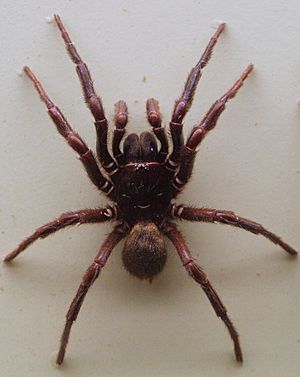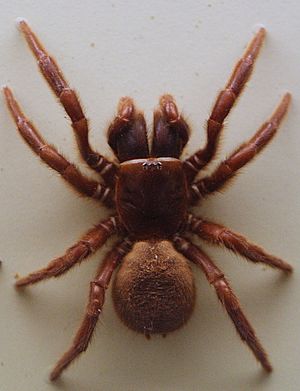Northern tree-dwelling funnel-web spider facts for kids
Quick facts for kids Northern tree-dwelling funnel-web spider |
|
|---|---|
 |
|
| male specimen on display in the Australian Museum | |
 |
|
| female specimen on display in the Australian Museum | |
| Scientific classification | |
| Synonyms | |
|
Atrax formidabilis Rainbow |
The Hadronyche formidabilis, also known as the northern tree-dwelling funnel-web spider, is a type of spider found in Queensland and New South Wales, Australia. It is famous for its powerful venom, which can be dangerous to humans. This spider is also called the Northern Rivers funnel-web spider or simply the northern funnel-web spider.
Contents
What is the Northern Funnel-web Spider?
This spider belongs to a group called Hadronyche. It was first described in 1914 by a scientist named William Joseph Rainbow. He found it near the Richmond River. The name formidabilis comes from a Latin word meaning "terrifying," which fits this spider well!
It is related to other funnel-web spiders, like the southern tree-dwelling funnel-web (H. cerberea) and the Blue Mountains funnel-web (H. versuta).
What Does the Northern Funnel-web Spider Look Like?
The northern tree-dwelling funnel-web spider has a shiny black body. Its legs and mouthparts are matte black or dark brown. Sometimes, its body might even have a purplish color.
It is one of the largest funnel-web spiders, growing up to 40-50 millimeters long. That's about the length of your thumb! Its body shape is longer and thinner compared to other spiders in its group.
This spider looks a lot like the Darling Downs funnel-web spider (Hadronyche infensa). However, male northern tree-dwelling funnel-webs have a special bump on their second pair of legs that the Darling Downs spider does not have.
How Dangerous is the Northern Funnel-web Spider?
When these spiders feel threatened, they stand up tall and show their fangs. You might even see drops of venom on their fangs. They cannot jump, but their bite can be very serious for people.
The venom of the northern tree-dwelling funnel-web spider is considered one of the most toxic among all funnel-web spiders. Many bites from this spider can cause severe symptoms. Luckily, there is an antivenom available. This antivenom, originally made for the Sydney funnel-web spider (Atrax robustus), works well for bites from this spider too.
If someone is bitten, symptoms can appear quickly, sometimes within 15 to 20 minutes. It is very important to apply pressure bandages and keep the person still. This can slow down the venom's effects.
Even though its venom is slightly different from the Sydney funnel-web, the symptoms are very similar. Common signs of a bite include:
- Lots of sweating
- High blood pressure
- Fast heartbeat
- Muscle twitching
- Feeling sick or throwing up
- Confusion
- Pain where the bite happened
Sometimes, fluid can build up in the lungs, which is called pulmonary oedema. Because these spiders are larger, they might inject more venom. This makes the northern tree-dwelling funnel-web spider possibly one of the most dangerous venomous spiders in the world.
Where Does the Northern Funnel-web Spider Live?
You can find the northern tree-dwelling funnel-web spider in eastern Australia. They live from South East Queensland down to the Hunter River in New South Wales.
Unlike many other funnel-web spiders that live on the ground, this species mostly lives in trees. It is one of only two Australian funnel-web species that prefer to live in trees. They make their homes in:
- Rotting logs
- Tree branches
- Hollow parts of trees, especially tallowwood trees (Eucalyptus microcorys)
- Plants that grow on other trees, called epiphytes
They have even been found living high up in trees, as much as 30 meters (100 feet) above the ground! Male spiders are often seen wandering around after rain and at night, usually between late October and early February. During the day, they look for shelter.
What Does the Northern Funnel-web Spider Eat?
Since these spiders live in trees, scientists believe they mostly eat beetles that bore into wood.

